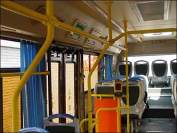Transportation plays an important role in each city of China. With improvements in road construction, more convenient transport options are available. Public buses, taxies, bicycles are the most common vehicles for you to take. In some modern and developed Chinese cities, subway, light rail and even Maglev trains can all be considered as good ways for you to get around the city. | 
|
In China, almost all major cities are equipped with a developed bus transport system. Bus transport is the main choice, in urban and suburban areas, for its economy and convenience.
The intercity long-distance bus is another option chosen by greater numbers of people due to the extension and development of highways in China. All the Chinese cities have coach stations, which can usually be found at the city's railway station. Busier tourist cites may have more than one coach station distributed throughout the city. Long-distance buses, running to almost all the other Chinese cities, especially the cities nearby, often depart at a certain interval. The operation time usually is from early morning to late at night, with seasonal variations in different cities. For much longer distance, fewer services will be run a day. Tickets, which may be purchased at the coach station in advance or from the conductor after you get on the bus, are much cheaper than a train fare. Make sure that you choose the right bus to the right direction since the coach station is always disordered and crowded. TV and air-conditioning are usually provided on the long-distance buses, some may also have a toilet and sleeping berth if you have an overnight journey. |